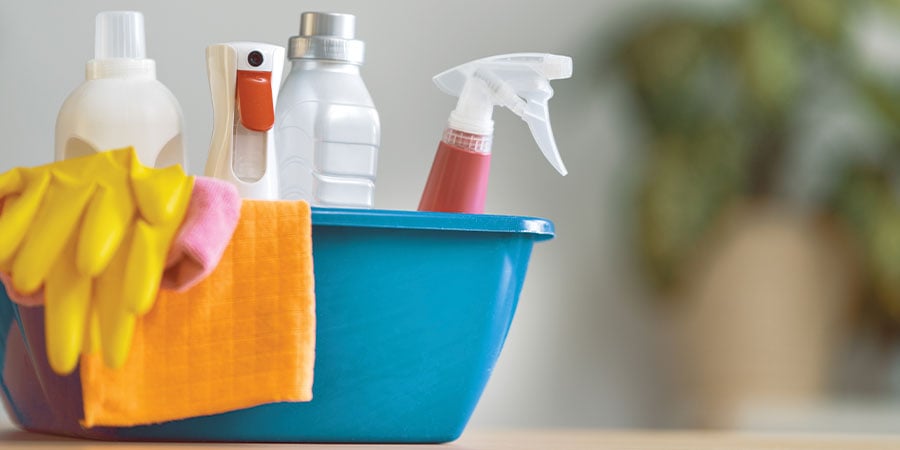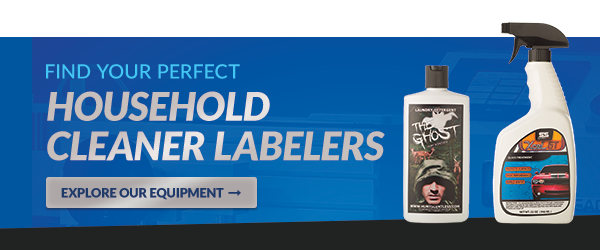
Great household cleaning product labels are compliant, made from the best-fit material, and are appropriately applied.
Household cleaning product labels are no different than labels for other consumer goods: you want them to grab attention to help sell the product and be durable enough to look good representing your brand all the way to the point of disposal.
But how long does your label need to last? Conditions are very different for, say, an all-purpose spray cleaner as opposed to a craft beer bottle. Like a mayfly — the insect with the shortest lifespan on earth, the beer can or energy drink bottle only hang around for a few fleeting hours. On the other hand, cleaners, laundry detergents, floor care products, furniture polish, and other household cleaning products can be in use for years.
Besides being handled much more, cleaning product labels must withstand exposure to chemicals and adhere to various shapes and sizes of spray bottles, squeeze bottles, jugs, and other kinds of containers.
In addition, regulatory requirements for consumer safety and warning information drive the need for solutions that maximize print area, such as shrink sleeve labels or extended-content labels that open up like the pages of a book (more on those later).
1. The Importance of Shelf Appeal

Of course, a top priority for any cleaning product label must be an eye-catching design that pops on the shelf. Late-stage product differentiation is a significant driver in the household marketplace, with container and label design playing a pivotal role in prompting impulse purchases. There is extremely high competition in the household chemicals market, and manufacturers are using tactics such as frequent design changes, new container types, and special label materials to compete. Whether you're selling household cleaning products, wine, or something else, pursuing label design inspiration should always be part of your thinking.
2. Labeling Law Compliance
Some sanitation and janitorial products require GHS labeling as hazardous chemicals. GHS stands for Globally Harmonized System of Classification and Labeling of Chemicals, and consists of standard symbols required internationally, including OSHA in the U.S.
Household products may not all need GHS labeling, but there are plenty of laws governing what they must contain to protect consumers (whether they actually do or not is debatable, but the fact that you must comply with labeling requirements is not).
- Fair Packaging and Labeling Act (FLPA) Administered by the Food and Drug Administration (FDA), this is intended to give buyers comparison shopping information while preventing deceptive labeling of household items. Consumer commodity labels must have such things as a statement that identifies the product, name, and location of manufacturer or distributor, and a display of the net quantity of content, by weight, volume, or count.
- Federal Hazardous Substances Act (FHSA) This act requires precautionary labeling on hazardous household products that helps consumers safely store and use them. It also tells consumers what immediate steps to take should the product be ingested or be improperly used, resulting in injury.
- Household Product Labeling Act of 2009 Companies are required to list all product ingredients on the label. This lets that percentage of consumers who actually read labels know whether harmful chemicals are present in cleaners used around the house on household objects like toys, phones, counters, etc.
- California Cleaning Product Right to Know Act of 2017
Requiring disclosure of ingredients on a variety of products — including cleaning products — this act requires companies to convey information both on product labels and online. Requirements are being phased in, and the first disclosure requirements took effect for products manufactured after January 1, 2020.
3. Making It All Fit
Given a constantly growing list of mandated information on cleaning product labels, the task of packing information about consumer safety, product ingredients, and instructions for use onto a normal-sized label might seem like fitting the entire Encyclopedia Britannica on the head of a pin.
Fortunately, label converters offer a couple of ways to go.
- Shrink sleeve labels provide a 150% increase in label area over traditional pressure-sensitive labels, at only a 25% cost increase. Setting aside their other benefits for a moment, which you can read about here, the increased area, covering 360 degrees around the container, provides room for instructions, warning labels, and other mandated content in addition to displaying the brilliant design and branding that's fundamental to moving product.

- Extended content labels (ECLs) are often the back label of a front-and-back label system, with the front attractively designed to catch the eye with a branding message, and the back reserved for safety information and instructions. These labels can peel open to reveal text and graphics, and sometimes extend to several pages, and are called "booklet labels." With new space to play in, your label designer could go beyond information needed merely for compliance and provide coupons, recipes, games, or other creative content.
4. Material Choice & Durability
Because they have to endure exposure to chemicals, water, sunlight, and abrasion, household cleaner labels can't just be made of ordinary paper. But paper's not out of the game—it's just gone high tech, like this top-coated Kraft paper that 3M modestly calls "Versatile Print Label Material."
Pressure-sensitive paper labels can be protected with high-gloss laminates to withstand water, oil, and chemicals in industrial kitchens, bathrooms, and other frequently-cleaned places. For example, Lightning Labels markets cleaning product labels made with a variety of materials to adapt to various container types and sizes, and products such as bleach, stain removers, and window cleaners.
But while about two-thirds of the market is still pressure-sensitive labels, shrink sleeve labels are gaining ground globally, and certainly are well-suited to the durability and flexibility requirements of cleaning products. They conform to odd shapes and work well with squeeze bottles. Since they're printed on the inside, they are very resistant to damage and abrasion. See our June 2020 post, What You Need to Know About Shrink Sleeve Labels, to get the full picture of their benefits.
Conclusion
Successful household cleaning products labeling is a matter of knowing your stuff when it comes to label contents (design, branding, legal compliance), then picking the right label type and materials (topcoats, liners, inks, adhesives) for your container. A great way to wrap up your education on the subject is to explore Pack Leader USA's household cleaner labelers page. Of course, if you have any further questions on the subject, we'll be happy to help.
















